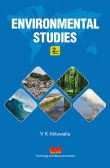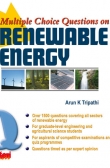Solar Photocatalysis for Environmental Remediation
Book Details
The book presents a review of research and pilot-scale efforts undertaken by scientists all over the world towards utilization of solar energy for environmental remediation. It gives a complete account of the solar photocatalytic degradation of pollutants present in wastewater and atmosphere and also discusses the solid-phase photocatalytic degradation of plastics in the form of composite. The text further describes the hydrogen generation by photocatalytic water splitting. Various solar collectors and reactors used especially for environmental remediation are also elucidated.
Environmental application of solar energy is a highly interdisciplinary subject encompassing chemistry, chemical engineering, photonics, materials science, and environmental science and engineering. This book is an attempt to provide a compilation of research on the degradation of solid, liquid, and gaseous pollutants using solar energy. It will prove to be an ideal text for readers interested in exploring the use of solar energy to remediate environmental problems.
About The Author
Sampa Chakrabarti, PhD, is Professor, Department of Chemical Engineering, University of Calcutta, West Bengal. She obtained her BSc, BTech, MTech, and PhD degrees in Chemical Engineering from University of Calcutta, India. Before pursuing her PhD on the application of Chemical Engineering for environmental remediation, she worked in reputed engineering consultancy organizations in India for 11 years. Dr. Chakrabarti has published more than 60 research papers in reputed journals and conferences and has over 1200 citations till date. Her research interest includes photo- and sono-advanced oxidation processes for environmental remediation and sonochemical synthesis of nanoparticles with several applications, including synthesis of smart surfaces. She has also worked as visiting researcher at State University of New York at Buffalo, NY, USA and Washington University in St. Louis, MO, USA. Prof. Chakrabarti is a keen reader of literature, especially Bengali literature. She has also published several scientific articles in little magazines in simple Bengali to popularize science among common people.
Target Audience
-
Students and professionals of Solar Energy
Table of Contents
Introduction
Advanced Oxidation Processes and Photocatalysis
Photocatalysis and Photosensitization
Solar Collectors and Reactors for Environmental Applications
Non-concentrating Collectors and Reactors
Concentrating Collectors and Reactors
Concentrating Versus Non-concentrating Reactors
Tracking and Non-tracking Systems
Materials of Construction for Solar Reactor
Reactors for Water Treatment
Reactors for Treatment of Plastic Pollutants
Reactors for Treatment of Polluted Air
Commercial Photoreactors and Challenges
Solar Energy for Water and Wastewater Treatment
Distillation and Desalination using Heat of the Sun
Detoxification using Light of the Sun: Homogeneous and Heterogeneous Photocatalysis
Homogeneous Photocatalysis: Photo-Fenton Reactions
Photocatalytic Mineralization and Decrease in Chemical Oxygen Demand
Reduction of Biological Oxygen Demand
Solid-phase Photocatalytic Degradation of Plastic Films
Polymers Degraded
Photocatalysts
Preparation and Characterization
Semiconductor–Polymer Composite
Photoreactors used
Photocatalytic Degradation
Reaction Mechanism and Kinetics
Photocatalysis for Control of Air Pollution
Catalysts used for Photo-remediation of Pollutants in Air
Model Pollutants used for Photo-remediation
Degradation of Pollutants, Possible Kinetics, and Mechanism
Reactor Configuration for Photocatalytic Treatment of Air Pollution
Commercial Photocatalytic Construction Materials for Air Pollution Control
Solar Water Splitting
Steps and Chemical Reactions
Photocatalysts
Enhancing Photo-water Splitting
Reactors used for Water Splitting
Influence of Process Parameters on Water Splitting
Conclusion
Reference
Glossary
Index
About the Author
Keywords
You may also like...
-
 Books for MNRE Scientist-B (Group A - Gazetted) Exam
Regular Price 550.00
Special Price 550.00
Books for MNRE Scientist-B (Group A - Gazetted) Exam
Regular Price 550.00
Special Price 550.00
-
 Environmental Studies (Second Edition)
Regular Price 325.00
Special Price 293.00
Environmental Studies (Second Edition)
Regular Price 325.00
Special Price 293.00
-
 The Land of the Setting Sun & Other Nature Tales
Regular Price 250.00
Special Price 225.00
The Land of the Setting Sun & Other Nature Tales
Regular Price 250.00
Special Price 225.00
-
 Multiple Choice Questions on Renewable Energy
Regular Price 395.00
Special Price 356.00
Multiple Choice Questions on Renewable Energy
Regular Price 395.00
Special Price 356.00


